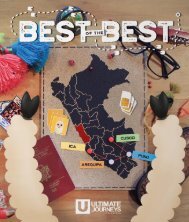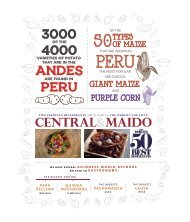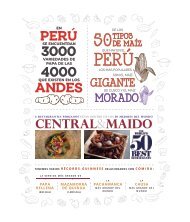UJ #17 - Traditional Peru
You also want an ePaper? Increase the reach of your titles
YUMPU automatically turns print PDFs into web optimized ePapers that Google loves.
DECEMBER | CHRISTMAS TRADITIONS<br />
Diego Nishiyama<br />
Millions of people across the globe come together over<br />
the Christmas holidays to enjoy a special time with their<br />
loved ones. Despite this being a worldwide event, each<br />
country’s essence is reflected in the unique way they<br />
celebrate this festivity.<br />
In <strong>Peru</strong> there is a great amount of syncretism between the<br />
original, regional rituals, and the later imposed Catholic<br />
religion. Thus, it is common for each area of the country<br />
to incorporate their unique customs into celebrations,<br />
some of which reflect traditions and characteristics that<br />
range from the weather to the general temperament of<br />
the population.<br />
In Cusco’s Main Square, December 24th brings with it<br />
hundreds of artisans who line the sidewalks with their<br />
handmade products. Known as Santuranticuy, this is the<br />
city’s most important Christmas tradition, dating back to<br />
Herbs, incense,<br />
and other<br />
elements come<br />
together to<br />
complement<br />
traditional<br />
nativity scenes.<br />
viceroyal times, when artisans gathered from near and far<br />
in hopes to make money.<br />
At the fair, shoppers can purchase a variety of figurines<br />
made from clay or carved from wood in order to assemble<br />
their own nativity scenes. The Niño Manuelito is the main<br />
figure sold here, an interesting representation of a young<br />
Jesus with white skin, light eyes, and Andean garments.<br />
Over in Ayacucho, however, there is a different nativity<br />
representation of equal importance: the retablo. Rather<br />
than collecting various pieces to create a composition,<br />
like in the Cusco nativity scenes, the retablos are one,<br />
Walking the<br />
Santiranticuy, one<br />
can appreciate<br />
history-infused<br />
art from many<br />
Andean towns.<br />
LimaTours<br />
Diego Nishiyama<br />
THE WORD SANTIRANTICUY COMES<br />
FROM A COMBINATION OF QUECHUA<br />
WORDS: ‘SANTU,’ WHICH MEANS SAINT,<br />
AND ‘TICUY,’ WHICH MEANS SALE.<br />
THUS, SANTIRANTICUY MEANS ‘SALE OF<br />
SAINTS.’<br />
78<br />
The retablos from Ayacucho stand out for their<br />
colors and fine craftsmanship.

















